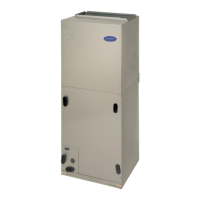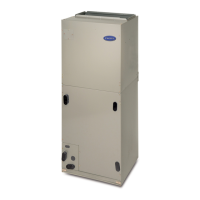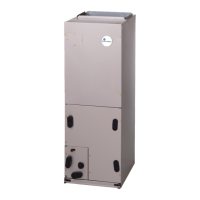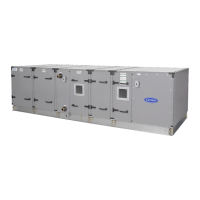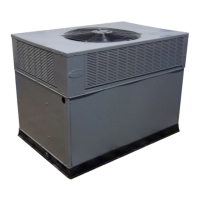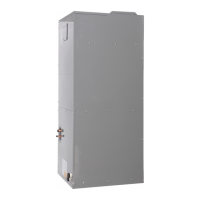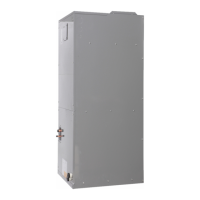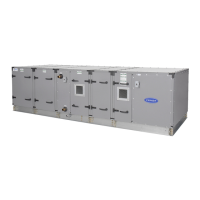FB, FE, FF1E, FFM, FG, FH, FJ, FMA, FT, FV, FX, FY, FZ, F54, PF: Service and Maintenance Instructions
Manufacturer reserves the right to change, at any time, specifications and designs without notice and without obligations.
30
A93530
Fig. 28 – Refrigerant Flow-Control Device (For FB and FMA4P)
Piston Body Cleaning and Replacement
1. Pump down outdoor unit. Close service valves at outdoor unit.
2. Recover remaining refrigerant from tubing and coil through gage
port on vapor-tube service valve. Disconnect refrigerant (liquid)
tube from piston body (Fig. 28).
3. Avoid damaging seal ring or machined surfaces on piston, bore, and
retainer.
4. Using small wire with a hook on end of it, remove piston from
body.
1. Install new or cleaned piston into body.
2. Replace seal ring on retainer.
3. The threads are coated with Loctite Heavy Duty Anti-Seize. It is
recommended to reapply with the same thread sealer.
4. Reconnect refrigerant tube to piston body.
5. Pressurize tubing and coil, then leak check.
6. Evacuate tubing and coil as necessary.
Liquid Tube Strainer
In R-22 all units, the TXV and refrigerant flow-control device is
protected on the indoor coil by a wire mesh strainer. It is located inside
the 3/8" liquid tube at field braze joint just outside unit casing. Access to
strainer is through field braze joint.
Aluminum Coil Repair
Repairing leaks on aluminum coils is possible using the aluminum
brazing method. Specific braze and flux material designed for aluminum
are necessary for aluminum brazing. A kit containing all materials
necessary for making and aluminum braze repair is available through
Replacement Components (kit No. 337748-751).
Do not use a previously-used wire brush to clean copper when preparing
an aluminum braze site. Copper particles in contact with an aluminum
coil may cause premature failure. Service aluminum coils are also
available as a coil repair option.
NOTE: Replacement of an indoor slope or A-coil must include recovery
and recycling of refrigerant currently in the system. Provided the
refrigerant has not been contaminated with moisture, acid, solid
particulate, or non-condensibles, it may be recovered by following the
procedures listed below. However, if the refrigerant is contaminated,
recycling or reclaiming methods are required. If leaks are present in the
system, meaning the refrigerant may be contaminated, recycling or
reclaiming methods MUST be used. Installation of new filter drier(s) is
required. The filter drier-type will depend upon the contaminants in the
system. See Split-System Residential Air Conditioners and Heat Pumps
Service Manuals for further information.
Pre-Installation
Except for coils only used with TXV fan coils, all-aluminum
replacement coils are shipped with a piston body distributor, piston, and
90 degree inlet tube with piston retainer (including Teflon seal). Coil
sizes used only with TXV fan coils include the TXV as part of the
replacement coil.
PISTON
PISTON
RETAINER
BRASS
HEX NUT
BRASS
HEX BODY
TEFLON SEAL
CAUTION
!
ENVIRONMENTAL HAZARD
Failure to follow this caution may result in environmental damage.
Do not vent refrigerant to atmosphere. Recover during system repair or
final unit disposal.
CAUTION
!
UNIT DAMAGE HAZARD
Failure to follow this caution could result in equipment damage.
Damage may occur to the scroll compressor if operated at a negative
suction pressure during a system pumpdown.
CAUTION
!
UNIT DAMAGE HAZARD
Failure to follow this caution could result in equipment damage.
When cleaning the piston orifice, be careful not to scratch or enlarge the
opening, as this will affect operation.
CAUTION
!
UNIT DAMAGE HAZARD
Failure to follow this caution could result in equipment damage.
Use a backup wrench and do not over tighten, as deformation of the
piston body will occur, causing the piston to lodge in a partially open or
closed position.
WARNING
!
PERSONAL INJURY HAZARD
Failure to follow this caution may result in personal injury.
Relieve pressure and recover all refrigerant before system repair or
final unit disposal to avoid personal injury or death. Use all service
ports and open all flow-control devices, including solenoid valves.

